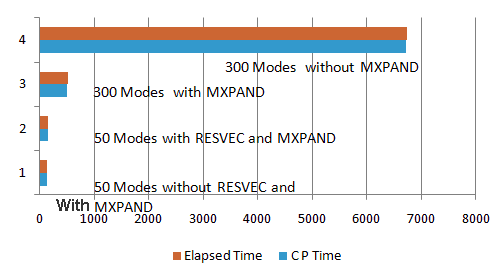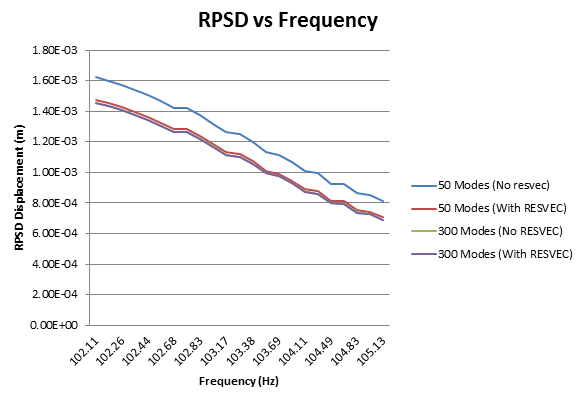The following topics are discussed in this section:
PSD analysis is performed with a large number of modes first. Using the
MXPAND command (MSUPkey = YES) to
store the modal element results significantly improves the efficiency in the
downstream modal superposition expansion pass. Reduction of the number of modes used
also reduces the solution time, but at the expense of accuracy. Accuracy can be
improved without a significant increase in the solution time by using residual
vectors.
The figure below shows the elapsed and CPU times with and without the residual
vector method and the expansion of the modes. Significant reduction in the solution
time is achieved with the use of MSUPkey = YES.
The solution time is slightly increased with the residual vector. For 50 modes, the elapsed time with and without the residual vector are 143.00 and 137.42 seconds, respectively.
The mode shape of the residual vector obtained using 50 modes (the 51th mode being the residual vector) is shown in the figure below. Note that the residual vector corresponds to a displacement in the y direction.
The residual vector method uses an additional vector computed in the modal analysis pass in addition to the eigenvectors in the modal transformation. This increases the accuracy of the response solution. RPSD displacement solutions with and without the residual vector are listed in the table below. For 50 modes without the residual vector, accuracy of the results is poor, as shown in column A in the following table. Accuracy is significantly improved with the use of the residual vector, as shown in column B.
| Number of Modes | % Diff with Column C | ||||
|---|---|---|---|---|---|
| Frequency |
50 (No RESVEC) Column A |
50 (With RESVEC) Column B |
300 (Full Model) Column C |
50 (No RESVEC) |
50 (With RESVEC) |
|
102.11 |
1.62 x 10-3 |
1.48 x 10-3 |
1.46 x 10-3 |
10.96 |
1.37 |
|
102.18 |
1.60 x 10-3 |
1.45 x 10-3 |
1.43 x 10-3 |
11.89 |
1.40 |
|
102.26 |
1.57 x 10-3 |
1.43 x 10-3 |
1.41 x 10-3 |
11.35 |
1.42 |
|
102.35 |
1.54 x 10-3 |
1.40 x 10-3 |
1.38 x 10-3 |
11.59 |
1.45 |
|
102.44 |
1.50 x 10-3 |
1.36 x 10-3 |
1.34 x 10-3 |
11.94 |
1.49 |
|
102.56 |
1.46 x 10-3 |
1.33 x 10-3 |
1.31 x 10-3 |
11.45 |
1.53 |
|
102.68 |
1.42 x 10-3 |
1.29 x 10-3 |
1.27 x 10-3 |
11.81 |
1.57 |
|
102.68 |
1.42 x 10-3 |
1.28 x 10-3 |
1.27 x 10-3 |
11.81 |
0.79 |
|
102.83 |
1.37 x 10-3 |
1.24 x 10-3 |
1.22 x 10-3 |
12.30 |
1.64 |
|
102.99 |
1.32 x 10-3 |
1.19 x 10-3 |
1.17 x 10-3 |
12.82 |
1.71 |
|
103.17 |
1.26 x 10-3 |
1.13 x 10-3 |
1.12 x 10-3 |
12.50 |
0.89 |
|
103.21 |
1.25 x 10-3 |
1.12 x 10-3 |
1.10 x 10-3 |
13.64 |
1.82 |
|
103.38 |
1.20 x 10-3 |
1.07 x 10-3 |
1.06 x 10-3 |
13.21 |
0.94 |
|
103.61 |
1.13 x 10-3 |
1.01 x 10-3 |
9.94 x 10-4 |
13.68 |
1.61 |
|
103.69 |
1.11 x 10-3 |
9.92 x 10-4 |
9.75 x 10-4 |
13.85 |
1.74 |
|
103.88 |
1.07 x 10-3 |
9.45 x 10-4 |
9.29 x 10-4 |
15.18 |
1.72 |
|
104.11 |
1.01 x 10-3 |
8.91 x 10-4 |
8.75 x 10-4 |
15.43 |
1.83 |
|
104.17 |
9.94 x 10-4 |
8.78 x 10-4 |
8.62 x 10-4 |
15.31 |
1.86 |
|
104.49 |
9.27 x 10-4 |
8.14 x 10-4 |
7.98 x 10-4 |
16.17 |
2.01 |
|
104.51 |
9.23 x 10-4 |
8.10 x 10-4 |
7.94 x 10-4 |
16.25 |
2.02 |
|
104.83 |
8.64 x 10-4 |
7.53 x 10-4 |
7.38 x 10-4 |
17.07 |
2.03 |
|
104.89 |
8.53 x 10-4 |
7.43 x 10-4 |
7.28 x 10-4 |
17.17 |
2.06 |
|
105.13 |
8.14 x 10-4 |
7.07 x 10-4 |
6.91 x 10-4 |
17.80 |
2.32 |
The following figure shows a subset of these values. The figure also contains RPSD values for 300 modes with the residual vector. As the frequency of this residual vector (1489 Hz) falls outside the range of the input frequency, there is hardly any change in result the for 300 modes. Hence, this is taken as the baseline for the analysis. Generally residual vectors should be used to increase accuracy and reduce the number of modes whose frequency is most likely to fall within the input frequency range for spectral analysis.





